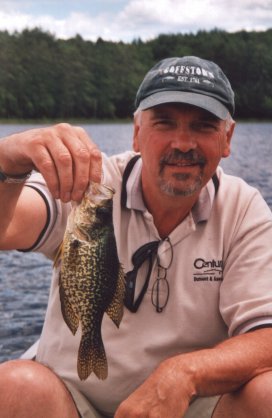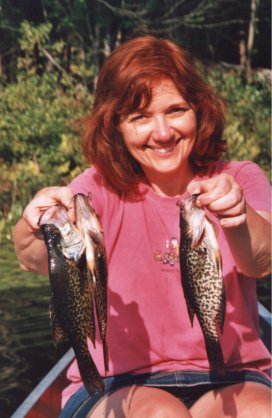July is a
great time to fish Black Crappie

Here it is July already, a great time to concentrate your fishing efforts on black crappies, definitely one of the finest of panfish in our state. As delightful as they are to catch and eat, these pretty fish will provide you with a summertime fishing challenge you’ll always enjoy.
Black crappie are actually a member of the sunfish family. They are known by many different names, typically based on geographic location, such as paper mouth, google eye and calico bass, to name a few.
The body of the black crappie is deep and strongly laterally compressed. Its forehead is depressed markedly, resulting in a noticeably turned-up snout. It has seven or eight spines in its dorsal fin and five to seven (usually six) in the anal fin. The black crappie is a very attractive silvery fish with numerous black or black-green mottling marks scattered over its body and fins. Black crappie inhabit quiet, weedy waters of lakes, ponds and rivers. Adults generally vary in size between 6 and 12 inches in length and weigh less than a pound. However, one to two pound fish, that measure as long as 16 or more inches, are common in New Hampshire waters. Their food is comprised largely of small crustaceans and small fish.


Neighbor Gerry McNeil
displays a nice crappie he
Elizabeth Valenti displays a few nice black
crappie
caught on July 14, 2009.
she caught on August 4, 2009
The black crappie was originally illegally introduced into a few waters of southern New Hampshire many years ago. Until recent years, it was never considered to be a game fish by our Fish and Game Department and was treated as just another panfish. However, over time, they came to realize just how popular the black crappie was with anglers. They then began a program of introducing black crappie into many other suitable waters around the state. Today, New Hampshire is blessed with a number of water bodies containing this highly fun to catch and delicious to eat fish. Black crappie are now found in waters of eight of our ten counties: Belknap, Carroll, Cheshire, Coos, Hillsborough, Merrimack, Rockingham and Strafford.
Compared to waters in southern and western states, our average black crappie are smaller in size. But, our waters do contain large ones from 12 to 17 inches in length, depending upon the waters habitat and food sources available to them and the amount of fishing pressure exerted upon the populations. The current New Hampshire state record black crappie was taken byTom Noyes, in the Bellamy Reservoir, in Madbury, N.H. during February of 2000. The fish was 17 inches long and weighed 2 pounds, 12.8 ounces, proving they are also a fun fish to catch in winter. Until recently, there were no creel limits on crappie. However, there is now a 25 fish daily limit.
Big bodies of water, such as Lake Massages (Auburn and Manchester), Pawtuckaway Lake (Nottingham) and Lake Winnipesaukee (Laconia) are three large lakes where a hook-up with large size black crappie is possible. And, there are many smaller water bodies that contain large size crappie, such as Turtletown Pond, in Concord. We also have crappie now in Goffstown’s Glen Lake. I enjoy trolling for them. The advantage being that you can cover a greater area of water rather than staying in one spot or fishing from shore. A depth finder is a great help in locating crappie activity, as well as indicating the depth at which they are active. If a school is encountered, stop your boat and try jigging or casting to them. When they stop biting or move off, begin trolling again.
Often, the best fishing is on a cloudy day. Crappie are very light sensitive. When the sun hit’s the water, they will drop down to a depth of from 5 to 10 or 12 feet deep, depending on water clarity. As the sun gets higher in the sky, they may retreat to a depth of 25 feet or more. When the sun begins to set, they tend to move back up toward the surface. But again, water clarity will make a difference. Another crappie behavior to remember is that they will come up for bait, but won’t dive down for it. Therefore, it is important to fish at whatever level they are swimming at or slightly above them.
What to use for catching black crappie? Live baits, such as worms, night crawlers and small minnows work. There are also any number of jigs and lures that will catch crappie. My favorites are the rubber-tailed jigs with various colors of jig-heads and tails. These come in a variety of weights and sizes. I prefer the one and one half and two inch rubber tails with jig-head weights in 1/16, 1/32 and 1/8th ounce sizes. In considering a jig selection, consider the light factors and the time of day you’ll be fishing. Bright day, bright lure. Dark day, dark lure. Having a variety of colors to choose from is best. Keep trying until you find the color combination that
produces the best action for you at that time and place.
For those who enjoy fly-fishing, New Hampshire’s black crappie can readily be caught on flies. Again, the trolling method will more often prevail, using full-sinking fly lines. If a notable school of fish are found, by all means, stop and enjoy casting to them. Recommended flies to use are wets, nymphs and streamers. Single hook streamers in sizes 10 and 8 work well. These should be of bait-fish patterns, as well as attractor patterns. Streamers like the Gray Ghost, Black-Nosed Dace, Mickey Finn, Black Ghost, Meredith Special, Beadhead Olive Crystal Bugger and the Beadhead Chartreuse Crystal Bugger are some good choices.
To learn more about waters in the state that contain black crappie populations, readers should obtain a copy of the New Hampshire Freshwater Fishing Guide. As you view this guide, bear in mind that the species number for black crappie is #15. This excellent guide is available from: Public Affairs Division, N.H. Fish and Game Department, 11 Hazen Drive, Concord, N.H. 03301 or call them at: (603) 271-3211.
Black crappie are one of the finest eating fish you could have on your plate. In my book, it ranks number one followed by white perch. I like them pan fried in cracker crumbs or cornmeal. However, I do release more fish than I ever take home. If you haven’t tried the challenge of fishing for black crappie, give it a try. Tight lines and good fishing.

Bob Harris can be
reached via e-mail at:
outwriter2@aol.com
Past
Columns by Bob Harris
>>>
About
Bob Harris
>>>
DISCLAIMER: The opinions
expressed by Mr. Harris are not necessarily those of the
Goffstown Residents Association or its members
Copyright©2010 Goffstown Residents Association. All Rights Reserved. |





